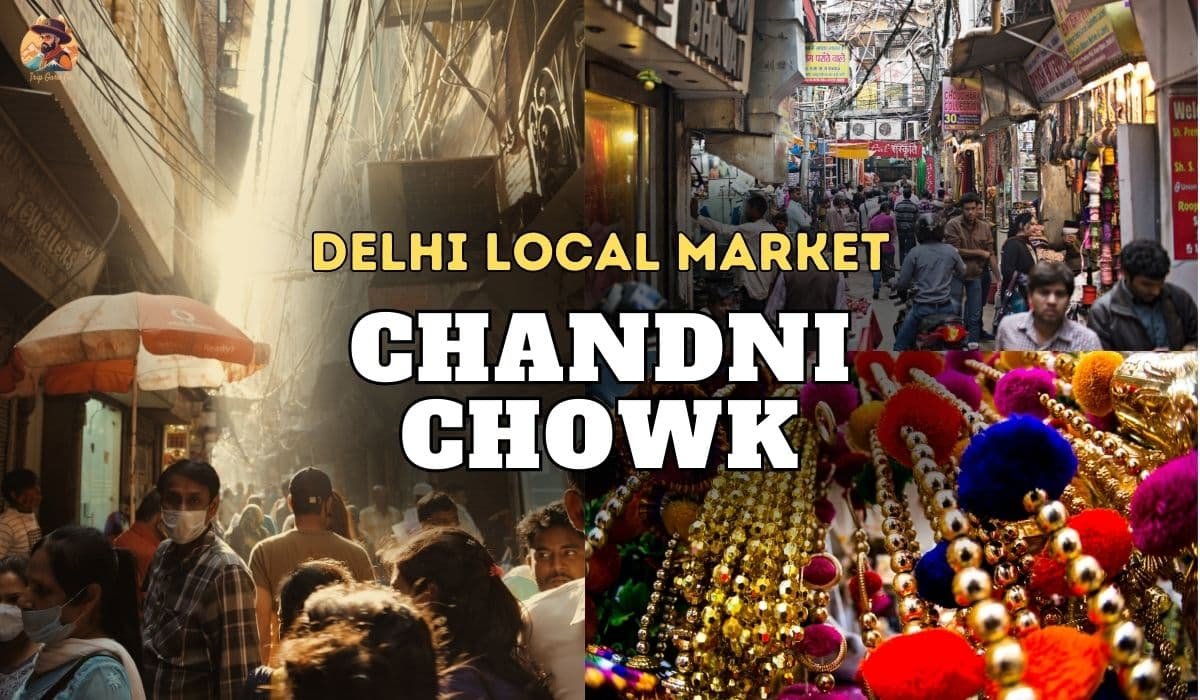Introduction:
Chandni Chowk is a busy street in the middle of Old Delhi that is full of history, culture, and business. This famous place has changed a lot over the years, and now it stands as a reminder of India’s long history. Located in Old Delhi, India, this market is like no other market. It is full of history and is always busy. In Chandni Chowk, one of the best places to visit in Delhi, offers a vibrant blend of history, culture, and commerce. Imagine a busy market near the Old Delhi Railway Station. At one end is the famous Red Fort.
In the 17th century, the Mughal prince Shahjahan built this fort. It is a reminder of India’s long and interesting history. There used to be rivers in Chandni Chowk that sparkled in the night, but they are now closed. It is now one of India’s biggest wholesale shops. In this article, we’ll take you on a tour of the charming streets of Chandni Chowk. We’ll talk about its history, why it’s important, and what both locals and tourists can do there. Come check out this busy place!
History of Chandni Chowk:
Chandni Chowk has been around since Emperor Shah Jahan built the Red Fort in his new city, Shahjahanabad. Chandni Chowk used to be a square in the shape of a half-moon in front of the Municipal Town Hall. In the middle was a waterway from the Yamuna River, and on both sides were roads and shops.
In 1650, Shah Jahan’s daughter, Princess Jahanara Begum, planned and opened Chandni Chowk. It was a square with 1,560 shops and a pool in the middle that sparkled in the night, which is how it got its name. The shops used to be set up in a half-moon shape, but that has now changed.
In the 1870s, they replaced the pool with the Ghantaghar clock tower, which still stands in the middle of the market. Chandni Chowk used to be India’s most important market, and it was where the Mughal emperors paraded. This practice continued in 1903 at the Delhi Durbar.
The British built the Delhi Town Hall in 1863. Today, Chandni Chowk still has the old-world charm of its past. It is full of people and offers a glimpse into India’s rich history.
Chandni Chowk: 1860s Photo
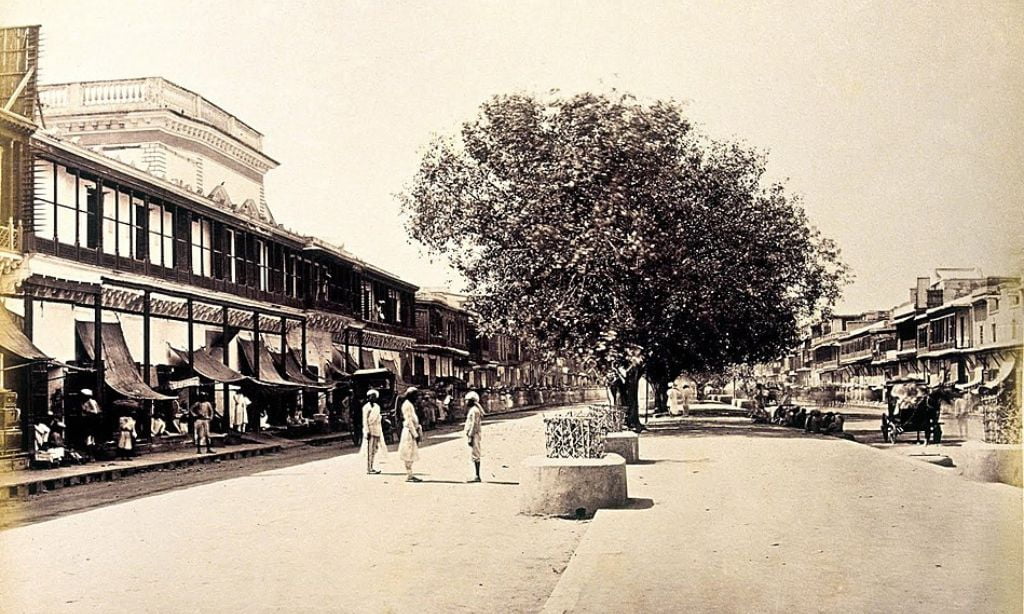
Chandni Chowk’s Historic Three Bazaars
In the time of Shahjahanabad, Chandni Chowk was a lively place with three busy bazaars. There were:
- Urdu Bazar: Spreading from the Lahori Gate of the Mughal royal house to Chowk Kotwali near Gurudwara Sis Ganj Sahib. It got its name from the fact that it was a market for people who camped out. The Urdu language comes from here. It suffered during the Indian Rebellion of 1857.
- Johri Bazar: This bazaar ran from Chowk Kotwali to Chandni Chowk, where the Ghantaghar used to stand in front of the Municipal/Town Hall.
- Fatehpuri Bazar: Fatehpuri Bazar was the name for the area from Chandni Chowk to Fatehpuri Masjid.
Today, the straight road from the Lahori Gate of the Red Fort to the Fatehpuri Masjid is all part of Chandni Chowk. Even though it’s busy now, the market still has a lot of historical charm.
Chandni Chowk’s Streets, Katras, and Havelis
At the heart of Chandni Chowk, there is much more than a bustling market. This road, which is now known as Chandni Chowk. It was once the gateway to a complex network of roads and buildings.
- Mohalla (neighborhood): This is where everything starts. It’s a private area with curvy Kuchas and Kartras.
- Kucha or Gali (street): Kucha, like Gali in Hindi, means a street. These streets were home to people who shared common attributes, often their occupations. Examples include Kucha Maliwara (gardeners’ street) and Kucha Ballimaran (oarsman’s street). Along these streets, you’d find large Havelis and gated cul de sac “Katras’ serving as marketplaces.
- Kucha Mahajani: This was a hub for gold trading and one of Asia’s largest wholesale jewelry markets.
- Katra (Gated Market-Residential Complex): Katras were like little communities of tradesmen and craftsmen who lived and worked together. These were gated cul de sac areas where the doors could be locked at night for security.
- Haveli (mansion): Haveli were grand houses with spacious courtyards surrounded by rooms. Begum Samru’s house, Dharampura Haveli, Ghalib ki Haveli, Haksar Haveli, and many more are all famous Havelis.
These words describe the complicated network of streets, shops, and houses that make up Chandni Chowk. Even though the market is now busy with modern life, these historical parts still give this famous spot in Delhi a special charm.
Chandni Chowk’s Historic Religious Sites:
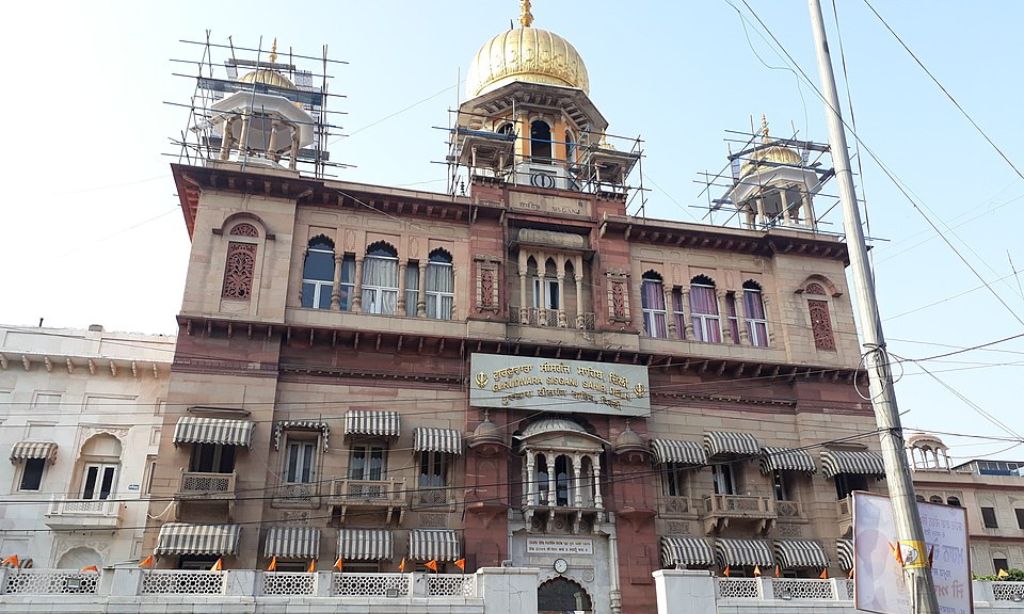
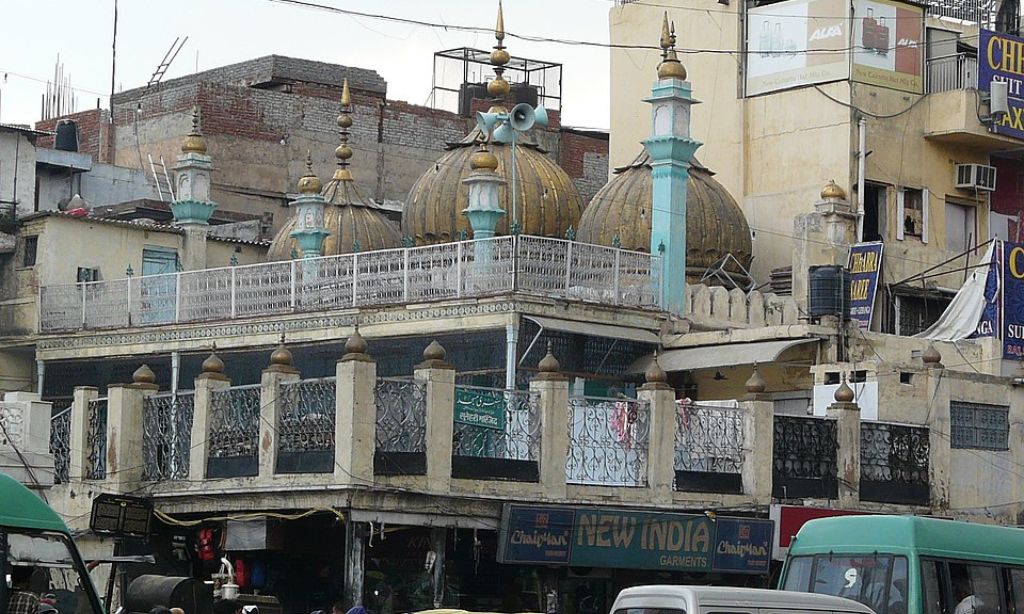

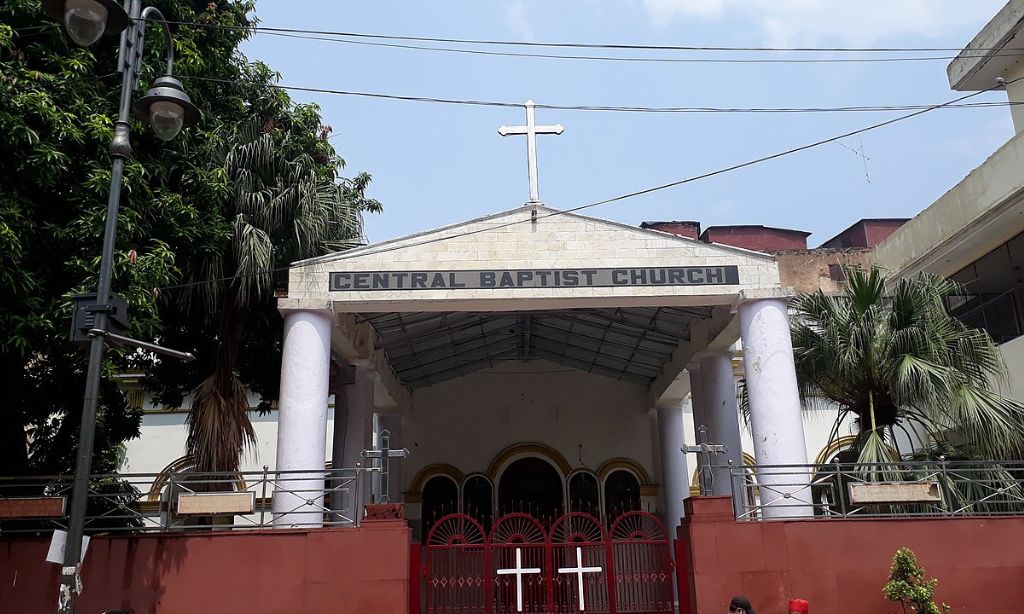
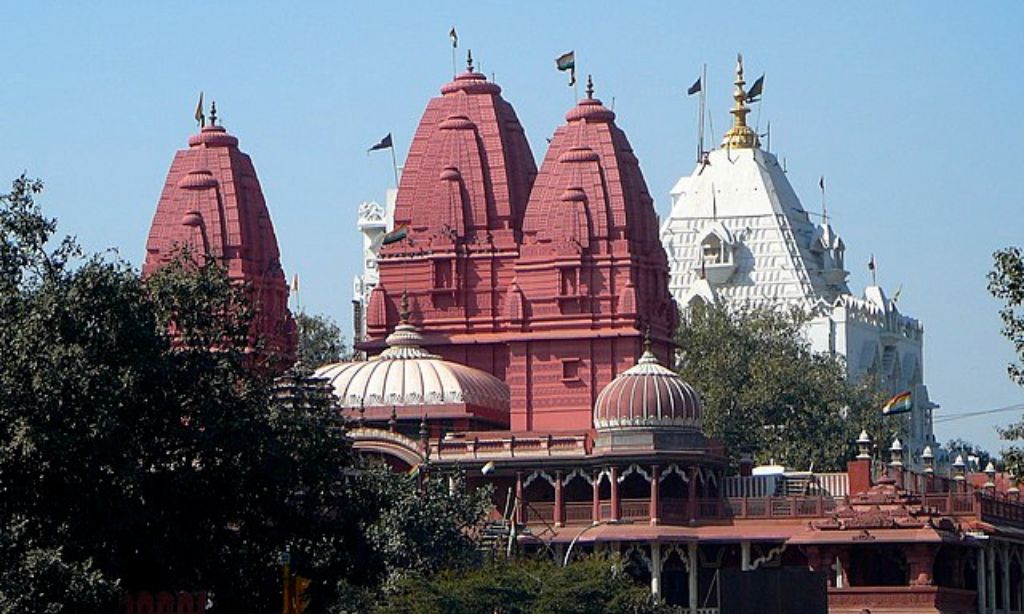
In the middle of Delhi, near the famous Red Fort, there is an amazing mix of different religions. It’s not only important because of its history, but also because it shows India’s many different religions.
- Sri Digambar Jain Lal Mandir: This Jain temple was built in 1656 and is well-known for the bird hospital that opened there in 1929. It’s a place where kindness and faith meet.
- Gauri Shankar Temple: There is a story that the Maratha general Appa Gangadhar built this temple. It’s a place where history and loyalty come together.
- Central Baptist Church: This church, which was built in 1814, is a different part of Delhi’s religious scene and a sign of the Christian faith.
- Gurdwara Sis Ganj Sahib: The death of Guru Tegh Bahadur and his followers in 1675 is remembered at this holy Sikh site. It stands as a sign of strength and commitment.
- Sunehri Masjid: Built-in 1721, this mosque saw history as Persian invader Nader Shah observed a tragic event in 1739. It’s a reminder of the city’s complex past.
- Fatehpuri Masjid: This mosque is a great example of Mughal architecture. In 1650, Fatehpuri Begum, one of Shah Jahan’s queens, built it.
These religious buildings, side by side, tell the story of coexistence and diversity. They are proof that people of different religions can live together in peace in India’s capital, where history and culture go hand in hand.
Chandni Chowk Today: Exploring Delhi’s Vibrant Street
If you walk down Chandni Chowk today, you’ll find yourself in a place where history and the hustle and bustle of modern life mix. This wide road is surrounded by lovely old areas linked by small streets called “gali.” These lanes are a great trove of street vendors, food stalls, and busy bazaars. Chandni Chowk is famous for its busy market, where people can buy, among other things, clothes, books, jewelry, and spices. This busy place has good deals and a lot of tasty street food. It’s a great place to go shopping because you can find almost everything you need without spending too much.
The Variety of Shops: Something for Everyone
Chandni Chowk is famous for its incredible variety and authentic offerings. You can find over a thousand types of food, sweets, and delicacies. The sarees here are adorned with beautiful chikan and zari work. As you explore the narrow lanes, you’ll come across shops selling everything from books, clothing, electronics, and consumer goods to shoes and leather items.
Taste the Local Delicacies: Jalebis in Pure Ghee
Don’t miss trying the local delicacies, especially the jalebis fried to perfection in pure ghee. These sweet treats are a must-try when you visit.
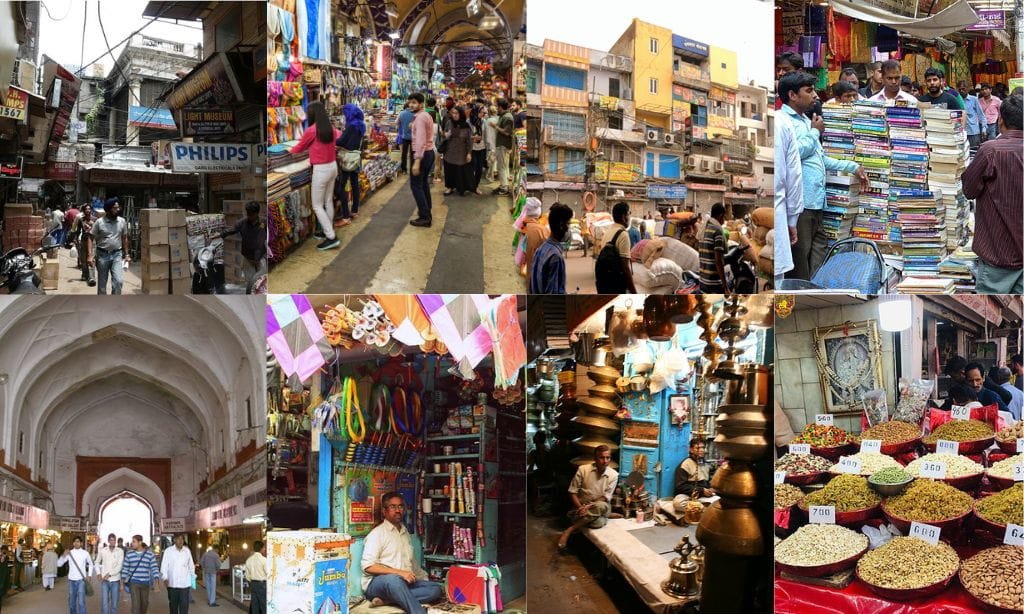
Notable Landmarks and Markets:
- State Bank of India: As you start from the Red Fort end, you’ll spot the State Bank of India building.
- Bhagirath Palace: This place has an interesting past and is a hub for electrical goods, lamps, light fixtures, medical supplies, and other connected goods.
- Dariba Kalan: If you’re looking for silver and gold jewelry, this is the place to be. You can also find trophies, shields, mementos, and more here.
- Bazar Guliyan: Near Jama Masjid, there are about a hundred shops that sell figures, sculptures, bells and other items made of metal and wood.
- Nai Sarak: This is a trade market where you can buy stationery, books, paper, and things to decorate with.
- Chawri Bazar: This market has everything you need, from welcome cards and wedding cards to plumbing and bathroom supplies.
- Lal Kuan: For hardware and hotel kitchen equipment at wholesale prices, head to Lal Kuan.
- Khari Baoli: Located at the western end of Chandni Chowk, this street is a paradise for spice lovers. You’ll find a wide range of spices, dried fruits, nuts, herbs, grains, lentils, pickles, and preserves.
- Tilak Bazaar: This is the place for industrial chemicals at wholesale rates.
- Cloth Market: The Cloth Market is where you can find materials for decorating your home, as well as ready-made things and design services.
Chandni Chowk is a lively and famous part of Delhi that has something for everyone. As you walk through its streets and shops, you’ll be steeped in the rich culture and business of India. Have a good time!
Popular places to eat in Chandni Chowk:
Chandni Chowk isn’t just about shopping; it’s a food lover’s paradise too! Here are some must-visit eateries:
- Gali Paranthe Wali: Famous for parathas since 1875.
- Annapurna Bhandar: Established in 1929, known for Bengali sweets.
- Bikaner Sweet Shop: Renowned for its delectable ras malai.
- Chaatwallah: Serving fruit chaat since 1923.
- Chaina Ram Sindhi Halwai: Since 1948, they have offered besan ke ladoo, ghee patisa, and ghevar like no other.
- Giani’s: A beloved spot since around 1947, known for ice creams and Rabri Falooda.
- Gole Hatti: Est. in 1954, famous for kullhad wale chole chawal.
- Hazari Lal Khurchan Wale: A 90-year-old shop known for the best khurchan in Delhi, a sweet treat made from milk and sugar.
- Kanwarji Bhagirathmal Dalbijiwallah: Serving since the mid19th century.
- Meghraj and Sons: A culinary institution since the 1950s.
- Natraj’s Dahi Bhalle: Serving delicious dahi bhalle since 1940.
- Shiv Misthan Bhandar: Est. in 1910, famous for their bedmi poori with aloo sabzi and crisp jalebi or imarti.
- Tewari Brothers Confectioners: Known for Motichoor Laddoo and samosas, established in 1987.
- The Old Famous Jalebi Wala: Located in Dariba Kalan, they serve the crispiest jalebis in the city.
Trying out these restaurants is a fun way to get to know the tastes of Chandni Chowk. Whether you live in India or are just visiting, you have to try these gems if you want to eat real Indian food.
Chandni Chowk in Bollywood:
Chandni Chowk shines in Bollywood. Lively streets, historic landmarks, and bustling markets star in iconic films. From narrow lanes to the Red Fort, it’s a character that brings Delhi’s magic to the screen. This market has served as a captivating backdrop for several Bollywood films, adding to its cinematic allure. Here are some notable movies that featured this iconic Delhi locale:
- Kabhi Khushi Kabhie Gham (2001): In this Bollywood classic, the leading lady Anjali (Kajol), and her sister Pooja (Kareena Kapoor) call Chandni Chowk their home.
- Black & White (2008): This movie is set in the lively area of Chandni Chowk and stars Anil Kapoor, Anurag Sinha, Shefali Chhaya, and Aditi Sharma.
- Chandni Chowk to China (2009): This action-packed movie has some exciting scenes that take place in Chandni Chowk. It stars Akshay Kumar, Deepika Padukone, Mithun Chakraborty, and Ranvir Shorey.
- Delhi-6 (2009): This movie stars Abhishek Bachchan and Sonam Kapoor, and it was shot in the old Walled City of Old Delhi, with Chandni Chowk in the middle.
- Saat Uchakkey (2016): This comedy movie with Manoj Bajpayee, Kay Kay Menon, Annu Kapoor, and others was shot fully in and around Chandni Chowk.
- Rajma Chawal (2018): A lot of this movie was made in Lachu Ram Ki Haveli, which is in Chandni Chowk. It stars Amyra Dastur, Rishi Kapoor, and others.
- The Sky Is Pink (2019): This movie stars Priyanka Chopra, Farhan Akhtar, and others. Parts of it were shot in Chandni Chowk, where Priyanka and Farhan’s characters lived.
| Movie | Year |
|---|---|
| Kabhi Khushi Kabhie Gham | 2001 |
| Black & White | 2008 |
| Chandni Chowk to China | 2009 |
| Delhi-6 | 2009 |
| Saat Uchakkey | 2016 |
| Rajma Chawal | 2018 |
| The Sky Is Pink | 2019 |
Chandni Chowk’s vibrant streets and rich cultural heritage continue to inspire filmmakers, making it a cherished part of Bollywood’s storytelling tapestry.
Chandni Chowk Revamp: A New Beginning
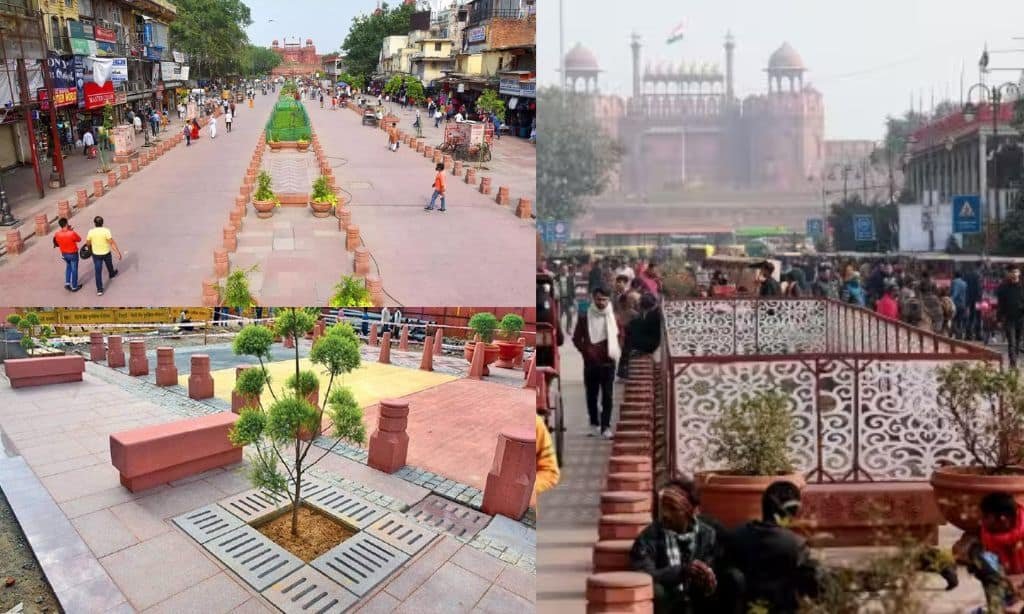
To promote tourism, Chandni Chowk was renovated, taking inspiration from the heritage streets of Amritsar. The Shahjahanabad Redevelopment Corporation under the Delhi government led this change. They gave a new look to the footpaths for pedestrians. Here motorized vehicles are banned between the Red Fort and Fatehpuri Mosque during the day. Roadways were decluttered and Ebus usage was encouraged. Though delayed, Delhi’s government is committed to completing this project under Deputy Chief Minister Manish Sisodia. Additionally, 1500 car parking spaces are planned.
A multilevel parking and commercial complex at Gandhi Maidan in Chandni Chowk is part of this effort. It was constructed at a cost of Rs 1,000 crore in PPP model with Omaxe. This parking space is spread over 18,524 square meters over eight floors with three basements, which can park more than 2,300 cars.
How to Reach Chandni Chowk?
Follow these easy steps to get to Chandni Chowk, one of the busiest and most important places in Delhi, India. You asked us to keep it simple and easy to understand, so we will:
1. Chandni Chowk Nearest Metro Stations:
- Lal Quila (Red Fort) Metro Station: This Delhi Metro station is right in front of Chandni Chowk and is on the Violet line.
- Jama Masjid Metro Station: It’s another good choice, and it’s only 1 kilometer from Chandni Chowk.
- Shastri Park Metro Station: Located on the Red Line, this station is near Chandni Chowk in Old Delhi.
- Chandni Chowk Metro Station: It’s on the Yellow line and less than a kilometer from this Market. It’s the most popular choice.
| Metro Line | Nearest Station | Walking Distance |
|---|---|---|
| VIOLET | Jama Masjid | 9 min walk |
| VIOLET | Kashmere Gate – Badarpur Border | – |
| VIOLET | Kashmere Gate – Raja Nahar Singh | – |
| ORANGE | New Delhi | 11 min walk |
| ORANGE | Dwarka Sector – 21 – New Delhi | – |
| YELLOW | Samaypur Badli – Huda City Centre | – |
| YELLOW | Qutab Minar – Vishwavidyalaya | – |
2. Chandni Chowk Nearest Bus Stops
| Bus Routes | Chandni Chowk Bus Stop |
|---|---|
| DTC buses | 102, 117, 425CL, 429CL |
Other Bus Stops: Nearby bus stops include Red Fort, Chawri Bazar, Old Delhi Railway Station, and Jama Masjid.
| Bus Station | Walking Distance |
|---|---|
| Red Fort | 4 min walk |
| Jama Masjid | 7 min walk |
| Ajmeri Gate / Kamla Market | 8 min walk |
| Subhash Park | 9 min walk |
| Old Delhi Railway Station | 9 min walk |
3. Car A Challenge Due to Traffic
- Traffic Caution: High traffic is common in this congested area, especially on weekends.
- Parking: While parking facilities are available, they often fill up quickly.
Distances to Chandni Chowk from Key Locations:
| Location | Approximate Distance from Chandni Chowk |
|---|---|
| Rajiv Chowk Metro Station | 4 kilometers |
| New Delhi Railway Station | 5 kilometers |
| Huda City Centre Metro Station | 35 kilometers |
| New Delhi Airport | 17 kilometers |
| Qutub Minar | 18 kilometers |
| Hazrat Nizamuddin Station | 11 kilometers |
| Noida | 25 kilometers |
| Karol Bagh | 5 kilometers |
| Gurgaon | 34 kilometers |
| Delhi University | 15 kilometers |
| Connaught Place (CP) | 5 kilometers |
| Laxmi Nagar | 8 kilometers |
| India Gate | 7 kilometers |
| Hauz Khas | 14 kilometers |
If you want to enjoy your trip to in this market without any problems, be smart about how you get there. Remember that Chandni Chowk can get very busy, so if you want to see this historic part of Delhi, be ready for a lively and colorful time. Have a good time!
Chandni chowk timings:
Here are the Chandni Chowk market timings:
- Chandni Chowk market is open on all days except Sundays.
- You can visit this market from 9:30 AM to 8:00 PM.
| Days of the Week | Market Timings |
|---|---|
| Monday | 9:30 AM – 8:00 PM |
| Tuesday | 9:30 AM – 8:00 PM |
| Wednesday | 9:30 AM – 8:00 PM |
| Thursday | 9:30 AM – 8:00 PM |
| Friday | 9:30 AM – 8:00 PM |
| Saturday | 9:30 AM – 8:00 PM |
| Sunday | Closed |
This table provides a clear view of Chandni Chowk market timings for each day of the week, including the days it is closed.
Chandni Chowk Nearby Places to Visit:
- Red Fort
- Jama Masjid
- Akshardham
- Fatehpuri Masjid
- Paranthe Wali Gali
- Haveli Mirza Ghalib
- Khas Mahal
- Gulabsingh Johrimal
- Diwan-i-Aam
- Delhi Food Walks
- India Gate
- Gurudwara Sis Ganj Sahib
- Shri Ram Hari Ram Jewellers
- Rang Mahal
- St. Stephen’s Church
- Jain Shwetambar Temple
- Mirza Ghalib Ki Haveli
- Chor Bazar
Things to Do in Chandni Chowk:
- Eat Street Food: Savor delicious street snacks like parathas and jalebis.
- Visit Jama Masjid: Explore the grand Jama Masjid and its minaret for views.
- Shop for Treasures: Bargain for clothes, jewelry, and spices in the markets.
- Heritage Walk: Discover history with a guided heritage tour.
- Rickshaw Ride: Enjoy a cycle rickshaw tour through the lanes.
- Spice Market: Visit Khari Baoli, the largest spice market in Asia.
- Indulge in Sweets: Try Indian sweets like gulab jamun.
- Capture Street Art: Admire vibrant street murals.
- Try Traditional Attire: Experience Indian clothing styles.
- Photography: Snap photos of the colorful chaos.
- Parathe Wali Gali: Relish stuffed parathas in this famous lane.
- Gauri Shankar Temple: Visit this serene Hindu temple.
- Street Performances: Enjoy live street acts.
- Unique Drinks: Taste jaljeera and lassi from local vendors.
- Antique Hunt: Explore shops for vintage items.
- Relax at Jain Temple: Visit Shri Digambar Jain Lal Mandir.
- Haveli Marvel: Admire old havelis’ architecture.
- Bargain Hunting: Explore flea markets for unique finds.
- People Watch: Sit at a local tea stall and observe the lively crowd.
Chandni Chowk is a fun place to go in Delhi because it has a lot of culture, history, and tastes.
Conclusion
In conclusion, Chandni Chowk in Old Delhi is a lively place that shows India’s rich history, culture, and business. It was first built by Princess Jahanara Begum. But this has changed over the years and it is now a busy market. Old streets, holy sites, and restaurants with delicious food surround this place. This famous place is a must-see in Delhi because it is a unique blend of old and new. Both people and visitors like to go there. Enjoy all the different things you can do there!
FAQs about Chandni Chowk
Chandni Chowk is a historic and bustling street located in the heart of Old Delhi, India. Its rich history, culture, and vibrant markets make it renowned.
Chandni Chowk market is famous for offering a wide variety of items, including clothes, books, jewelry, spices, and more. It’s a one-stop destination where you can find almost anything you need at affordable prices. Additionally, there are plenty of delicious food options available for shoppers.
Princess Jahanara Begum originally built Chandni Chowk in the 17th century. It used to be a square with a waterway in the middle that sparkled at night. Over the years, it has evolved into a bustling market.
Chandni Chowk was once divided into three busy bazaars: Urdu Bazar, Johri Bazar, and Fatehpuri Bazar. It is also home to numerous historic streets (Kuchas), gated courtyards (Katras), and grand mansions (Havelis).
Chandni Chowk boasts a variety of religious sites, including Sri Digambar Jain Lal Mandir, Gauri Shankar Temple, Central Baptist Church, Gurdwara Sis Ganj Sahib, Sunehri Masjid, and Fatehpuri Masjid.
Visitors to Chandni Chowk can experience a lively mix of history and modern life. Street vendors, food stalls, and a wide variety of shops selling everything from clothing to spices fill the area.
Yes, people know Chandni Chowk for its street food and eateries. Some must-visit places include Gali Paranthe Wali, Bikaner Sweet Shop, Gole Hatti, and many more offering delicious Indian cuisine.
They have revamped Chandni Chowk to boost tourism. This includes improved pedestrian access, limited daytime traffic, and a new multi-level parking facility.
Chandni Chowk remains open from 9:30 am to 8:00 pm every day, except for Sundays.
Chandni Chowk is known for its affordability. Despite being located in the bustling capital, it has managed to retain its old-world charm and is one of the most well-known and budget-friendly shopping destinations in Delhi.
Yes, Chandni Chowk is not only a great place for shopping but also offers a wide range of food options to satisfy your taste buds.
Yes, you can explore Chandni Chowk at night. A night walk around Chandni Chowk in Old Delhi allows you to experience the vibrant atmosphere of the capital city when it’s most alive in the evening.

